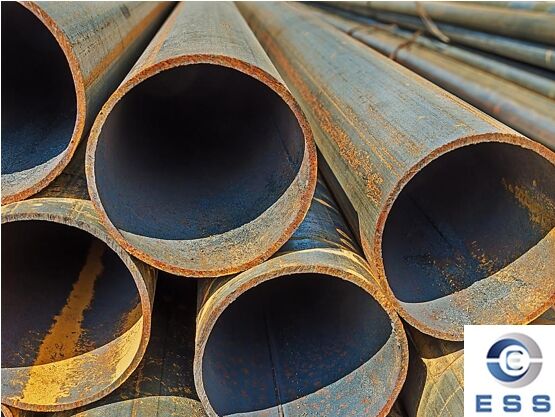
Basic principles of welding process
The welding process of boiler
tube mainly includes three types: gas welding, electric welding and
submerged arc welding. Among them, gas welding is suitable for thinner boiler
tube walls, electric welding is suitable for thicker boiler tube walls, and
submerged arc welding is suitable for thick-walled pipes as well as pipes with
high welding performance requirements, such as seamless
steel pipe.
During the welding process, the selection
of welding materials and electrodes also needs to be considered. The welding
material should be the same or similar to the material of the boiler tube to
ensure the tightness of the welded joint; the selection of electrodes also
needs to be determined according to the type and requirements of the welding
material. For different pipe materials, like carbon
steel pipe, the selection principles of welding materials and electrodes
are also different.
Steps of welding process
1. Preparation before welding
Clean the welding area to ensure that the
channel is unobstructed to avoid blockage during welding; at the same time,
heat the welding material to reduce welding deformation.
2. Welding operation
Perform welding operations by selecting
appropriate welding processes and welding equipment. For hydraulic
tubes, welding parameters and operating techniques need to be adjusted
during welding.
3. Post-weld treatment
After welding, the weld needs to be
polished, cleaned and inspected to ensure welding quality and sealing. For
pipelines with high requirements such as precision
tube, the flatness and finish of the weld need to be strictly controlled.
Welding materials
The selection of welding materials is
directly related to the compliance of performance indicators such as impact
resistance, heat resistance, and corrosion resistance. Depending on the
material of the boiler tube, the selected welding materials are also different.
For carbon steel boiler tubes, E4315, E5015
and other welding rods are generally used, which are suitable for submerged arc
welding and manual welding. If the welding quality requirements are high,
low-hydrogen welding rods E5016 or E5516 can be used. For special materials
such as alloy steel and stainless steel, choose the corresponding welding
materials for welding.
Matching principles of welding materials
1. Boiler tube welding should give priority
to welding materials with similar chemical composition and mechanical
properties to the parent material. For example, P91 steel pipes need to be
matched with ER90S-B9 welding wire to avoid the risk of embrittlement in the
heat-affected zone.
2. When welding dissimilar steels, the
martensitic transformation tendency of the organization needs to be evaluated
by the Schaeffler diagram.
Pre-welding pretreatment specifications
1. Use acetone to thoroughly remove grease
pollutants within 50mm on both sides of the groove.
2. Use a stainless steel wire brush to
treat the oxide layer until the metallic luster is exposed.
3. For boiler tubes with a wall thickness
of more than 25mm, a preheating and dehydrogenation treatment of 100-150℃ is required.
Welding process parameter optimization
1. When argon arc welding is used for base
welding, the current should be controlled at 90-110A, and the argon purity
should be ≥99.99%.
2. The submerged arc welding filling layer
adopts DC reverse connection, and the voltage is 28-32V matching the walking
speed of 500-550mm/min.
3. The interlayer temperature is strictly
kept within the range of not more than 50℃ above the
preheating temperature.
Quality assurance measures
1. The boiler tubes after welding should be
immediately subjected to stress relief heat treatment, and the heating rate
should be ≤150℃/h.
2. Delayed cooling for more than 24 hours
is required before 100% RT testing.
3. The hardness test value should be
controlled within 120% of the hardness of the parent material.
Safety protection requirements
1. Boiler tube welders must be equipped
with automatic darkening masks, flame-retardant work clothes and protective
leather skirts.
2. Forced ventilation systems and gas
detectors are required for confined space operations.
3. All welders must be equipped with
leakage protection devices, and the grounding resistance must be ≤4Ω.
Strict acceptance process
After welding is completed, it must pass a
strict acceptance inspection. This includes a detailed analysis of the chemical
composition of the material, a comprehensive test of the mechanical properties
of the weld, and non-destructive testing using X-rays, hydrogen cobalt lamps,
ultrasonic and other equipment. For parts such as pipe flange connected to boiler tubes, their welding quality also needs to be strictly
inspected. Only after this series of strict acceptance processes can the
quality of boiler tube welding be ensured.
Other additional requirements
1. The inside of the boiler tube must be
kept clean, and there must be no impurities such as oil and rust on the
external surface.
2. The weld surface of the boiler tube
should be smooth and free of defects such as cracks, pores or inclusions.
3. The post-welding treatment process of
the boiler tube should be carried out in a standardized manner to ensure the
uniformity of the quality of the welding area.
4. The installation layout of the boiler
tube should be reasonably planned to avoid any interference with normal
operation.
Summary
Welding is an indispensable part of the
boiler tube production process. Correct selection of welding materials and
methods, attention to welding details, and quality inspection can effectively
improve the service life and safety performance of the boiler tube.
Read more: How To Weld Boiler Tubes?













 Eastern Steel Manufacturing Co.,Ltd not only improve product production and sales services, but also provide additional value-added services. As long as you need, we can complete your specific needs together.
Eastern Steel Manufacturing Co.,Ltd not only improve product production and sales services, but also provide additional value-added services. As long as you need, we can complete your specific needs together.










